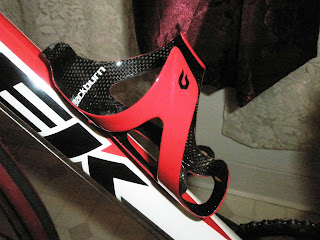A cycling club can satisfactorily sustain itself via
membership dues and benevolent, personal
contributions.
However, if a club wishes to take it to the next level, and they should,
seeking outside sponsorship is a quid pro quo no-brainer. Hey, it ranges from discounts, to free stuff,
and the flip-side is the shop receives free publicity via the club, plus the
increased business through the partnership.
Both parties benefit, and let’s face it – Interaction should be the
nucleus of cycling, anyway.
How to go about seeking sponsorship should begin with the
organization’s willingness to do so.
Basically, make sure everyone is on the same page, the goals are clear
and concise, and the sponsor has assurance to receive some return on their
investment. Remember, this is a
relationship. The shop sponsors the
club, and the club supports the shop.
Seems simple, right? Well, in
theory, yes. In reality, it takes a
little work to succeed.
The formula, however, is not really all that hard to realize if done correctly. In the exchange for
club support, the shop gets advertised by the club in various ways, from a logo
on the club kit, to mention on the clubs website or blog, to word of
mouth. The shop, in turn, also displays
the club’s name on the store front, in the store via a printed club newsletter,
the shop website, and even the clubs kit for purchase in-store. And this is just for starters. The creativity exchange is almost limitless.
The usual discount for a club from a shop is 10%. They can give 10% to their grandmother all
day, so strive for 20% to 25%. Remember,
since this is a business relationship, ask for more than is given to everyday
customers. The converse, however, is the
shop has a right to expect more from the club then everyday customers,
too. In the internet age, brick and
mortars have tough competition for your cycling dollars. Reward the shop with your business. Be there for them, and they will be there for
you.
Once the relationship is established, it is free to grow,
provided it is nurtured, and periodically evaluated for good health. Kept fit, the relationship can grow to levels
beyond imagination. Remember, it is
worth the effort, and do not let the partnership fail for any reason. And, most of all – Keep a line of
communication open at all times. By
being accessible to each other, the flow of information can assist both parties
in getting the most out of the partnership.
So far, so good, right?
Well, now for a word of caution.
I once put together a sponsorship package for an established
club with an up-and-coming shop, and that relationship was set to be a
long-term, transcendental affair, with discounts in excess of 40% off retail. Save for one small detail. Even with an initial outlay of $2000.00 USD
in free, yes free, tools, saddles, stems, bars, tires and nutrition, the stick
in the mud was the club’s then president whom just flat out said “No!” His reasoning? Well, he claimed if one shop agreed to
sponsor the club, then we should have many shops involved so as not to show
favoritism.
Did you get that? Did
you understand it? Good, because I
didn’t understand it, either.
In the end, the club lost my enthusiasm and support, the
shop decided to nix the sponsorship deal PERMANENTLY,
thus the club, and its membership, lost out on a good, reliable source of parts,
clothing, nutrition and free advertising.
All the shop wanted in return for the sponsorship was some publicity and
a growth in business from that publicity.
There were no threats of broken legs, no blood oath of loyalty, or
cement overshoes if the club failed to support the shop.
Epic fail? Oh,
yeah.
On another occasion I was talking to the owner of another
shop, which happens to be named after the same city a well-established club is
named after, and that owner claimed he has never, get this, NEVER, been approached by anyone in that
club, let alone any club, regarding a sponsor relationship. And he was indeed willing to do so, if asked. This situation was a classic example of an opportunity
looking for a partner.
Bottom line, if you seek to go after sponsorship for your
club, and again, you definitely should, make sure everyone has the clubs’ and
shops best interests at heart, as bad relationships in the small community
known as cycling are very hard to repair.
Remember, this is a long-term commitment. In an age of insincerity, and contracts not
being worth the paper they are printed on, it is high-time to return to honest,
personal, long-term relationships.
In the words of Mr. Miyagi in the original Karate Kid movie
– “First, make sacred pact.”
Yes, it is like that.



























